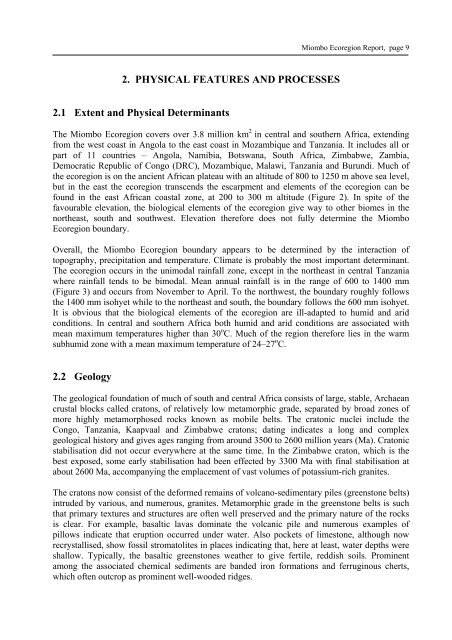Miombo Ecoregion Vision Report - Biodiversity Foundation for Africa
Miombo Ecoregion Vision Report - Biodiversity Foundation for Africa
Miombo Ecoregion Vision Report - Biodiversity Foundation for Africa
You also want an ePaper? Increase the reach of your titles
YUMPU automatically turns print PDFs into web optimized ePapers that Google loves.
2. PHYSICAL FEATURES AND PROCESSES<br />
2.1 Extent and Physical Determinants<br />
<strong>Miombo</strong> <strong>Ecoregion</strong> <strong>Report</strong>, page 9<br />
The <strong>Miombo</strong> <strong>Ecoregion</strong> covers over 3.8 million km 2 in central and southern <strong>Africa</strong>, extending<br />
from the west coast in Angola to the east coast in Mozambique and Tanzania. It includes all or<br />
part of 11 countries – Angola, Namibia, Botswana, South <strong>Africa</strong>, Zimbabwe, Zambia,<br />
Democratic Republic of Congo (DRC), Mozambique, Malawi, Tanzania and Burundi. Much of<br />
the ecoregion is on the ancient <strong>Africa</strong>n plateau with an altitude of 800 to 1250 m above sea level,<br />
but in the east the ecoregion transcends the escarpment and elements of the ecoregion can be<br />
found in the east <strong>Africa</strong>n coastal zone, at 200 to 300 m altitude (Figure 2). In spite of the<br />
favourable elevation, the biological elements of the ecoregion give way to other biomes in the<br />
northeast, south and southwest. Elevation there<strong>for</strong>e does not fully determine the <strong>Miombo</strong><br />
<strong>Ecoregion</strong> boundary.<br />
Overall, the <strong>Miombo</strong> <strong>Ecoregion</strong> boundary appears to be determined by the interaction of<br />
topography, precipitation and temperature. Climate is probably the most important determinant.<br />
The ecoregion occurs in the unimodal rainfall zone, except in the northeast in central Tanzania<br />
where rainfall tends to be bimodal. Mean annual rainfall is in the range of 600 to 1400 mm<br />
(Figure 3) and occurs from November to April. To the northwest, the boundary roughly follows<br />
the 1400 mm isohyet while to the northeast and south, the boundary follows the 600 mm isohyet.<br />
It is obvious that the biological elements of the ecoregion are ill-adapted to humid and arid<br />
conditions. In central and southern <strong>Africa</strong> both humid and arid conditions are associated with<br />
mean maximum temperatures higher than 30 o C. Much of the region there<strong>for</strong>e lies in the warm<br />
subhumid zone with a mean maximum temperature of 24–27 o C.<br />
2.2 Geology<br />
The geological foundation of much of south and central <strong>Africa</strong> consists of large, stable, Archaean<br />
crustal blocks called cratons, of relatively low metamorphic grade, separated by broad zones of<br />
more highly metamorphosed rocks known as mobile belts. The cratonic nuclei include the<br />
Congo, Tanzania, Kaapvaal and Zimbabwe cratons; dating indicates a long and complex<br />
geological history and gives ages ranging from around 3500 to 2600 million years (Ma). Cratonic<br />
stabilisation did not occur everywhere at the same time. In the Zimbabwe craton, which is the<br />
best exposed, some early stabilisation had been effected by 3300 Ma with final stabilisation at<br />
about 2600 Ma, accompanying the emplacement of vast volumes of potassium-rich granites.<br />
The cratons now consist of the de<strong>for</strong>med remains of volcano-sedimentary piles (greenstone belts)<br />
intruded by various, and numerous, granites. Metamorphic grade in the greenstone belts is such<br />
that primary textures and structures are often well preserved and the primary nature of the rocks<br />
is clear. For example, basaltic lavas dominate the volcanic pile and numerous examples of<br />
pillows indicate that eruption occurred under water. Also pockets of limestone, although now<br />
recrystallised, show fossil stromatolites in places indicating that, here at least, water depths were<br />
shallow. Typically, the basaltic greenstones weather to give fertile, reddish soils. Prominent<br />
among the associated chemical sediments are banded iron <strong>for</strong>mations and ferruginous cherts,<br />
which often outcrop as prominent well-wooded ridges.


